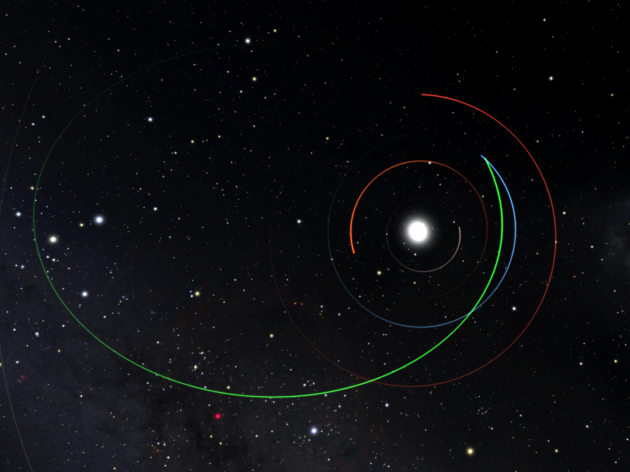[ad_1]

A new technique for finding potentially hazardous asteroids before they find us has chalked up its first success.
In this case, the asteroid isn’t expected to threaten Earth anytime in the foreseeable future. But the fact that the technique — which uses a new computer algorithm called HelioLinc3D — actually works comes as a confidence boost as astronomers get set to step up the asteroid hunt with the Vera C. Rubin Observatory in Chile.
The University of Washington’s DiRAC Institute will play a leading role in analyzing the data from the Rubin Observatory, and HelioLinc3D is meant to make the job easier. It’ll be another couple of years before the Rubin Observatory starts surveying the skies, but researchers put HelioLinc3D to the test by feeding it data from the NASA-funded Asteroid Terrestrial-impact Last Alert System, or ATLAS.
During the July 18 test run, the algorithm combined fragments of ATLAS data from four nights of observations to identify an asteroid that had been previously missed.
The asteroid, designated 2022 SF289 and described in a Minor Planet Electronic Circular, is thought to be about 600 feet wide. That’s wide enough to cause widespread destruction on Earth in the event of an impact. The good news is that projections of 2022 SF289’s orbital path show it staying 140,000 miles away from Earth at its closest. Nevertheless, the space rock fits NASA’s definition of a potentially hazardous asteroid because of its estimated size and the fact that it can come within 5 million miles of our planet.
UW researcher Ari Heinze, the principal developer of HelioLinc3D, said the algorithm’s success should carry over to the Rubin Observatory’s future database.
“By demonstrating the real-world effectiveness of the software that Rubin will use to look for thousands of yet-unknown potentially hazardous asteroids, the discovery of 2022 SF289 makes us all safer,” Heinze said in a news release.
Astronomers had missed identifying 2022 SF289 in their data because the asteroid passed in front of the bright star fields of the Milky Way. That provided a type of cosmic camouflage and made it difficult to collect multiple sightings on a single night, which is the typical route for asteroid discovery. In contrast, HelioLinc3D was able to piece together data from different nights to track the asteroid.
“Any survey will have difficulty discovering objects like 2022 SF289 that are near its sensitivity limit, but HelioLinc3D shows that it is possible to recover these faint objects as long as they are visible over several nights,” said Larry Denneau, a lead ATLAS astronomer from the University of Hawaii. “This in effect gives us a ‘bigger, better’ telescope.”
Once astronomers had a fix on 2022 SF289’s orbital path, they were able to locate the asteroid in images previously collected by Pan-STARRS, the Catalina Sky Survey and the Zwicky Transient Facility.
About 2,350 potentially hazardous asteroids have been detected to date, and based on statistical projections, astronomers say at least 3,000 more are yet to be identified. When the Rubin Observatory goes into action, HelioLinc3D is likely to become an important tool for identifying them.
“This is just a small taste of what to expect with the Rubin Observatory in less than two years, when HelioLinc3D will be discovering an object like this every night,” said UW astronomer Mario Jurić, who is the director of the DiRAC Institute. “But more broadly, it’s a preview of the coming era of data-intensive astronomy. From HelioLinc3D to AI-assisted codes, the next decade of discovery will be a story of advancement in algorithms as much as in new, large telescopes.”
Financial support for Rubin Observatory comes from the National Science Foundation, the U.S. Department of Energy and private funding raised by the LSST Corporation. In addition to Heinze and Jurić, members of the HelioLinc3D team include Siegfried Eggl, Joachim Moeyens, Lynne Jones, Ian Sullivan, Eric Bellm and Matthew Holman. ATLAS astronomers John Tonry and Larry Denneau contributed data for the algorithm’s test.
[ad_2]
Source link

